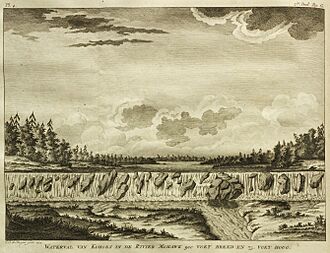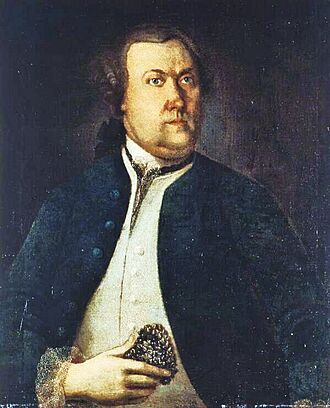Pehr Kalm facts for kids
Quick facts for kids
Pehr Kalm
|
|
|---|---|
| Born | 6 March 1716 |
| Died | 16 November 1779 (aged 63) |
Pehr Kalm (born March 6, 1716 – died November 16, 1779) was an important Swedish explorer and botanist. He studied plants, animals, and nature. He also looked at how farming could be improved. Pehr Kalm was a key student of the famous scientist Carl Linnaeus.
In 1747, a group of scientists asked him to travel to North America. His mission was to find new plants and seeds. These plants could then be used to help farming back in Sweden. Kalm was the first scientist to describe Niagara Falls. He also wrote the first scientific paper about the 17-year periodical cicada. This insect is called Magicicada septendecim.
Kalm wrote a book about his travels. It was translated into many languages. Today, you can still find it in English as Peter Kalm's Travels in North America.
Contents
Pehr Kalm's Early Life and Studies
Pehr Kalm was born in Ångermanland, Sweden. His parents, Gabriel Kalm and Katarina Ross, had moved there from Finland. They were trying to escape a big war called the Great Northern War. Pehr's father was a Finnish church leader. His mother had family from Scotland. Pehr's father died just six weeks after he was born.
After the war ended, his mother took him back to Närpes in Ostrobothnia. This was where his father had worked as a minister.
Becoming a Scientist
Pehr Kalm began studying at the Royal Academy of Turku in 1735. In 1740, he went to the University of Uppsala. There, he became one of the first students of Carl Linnaeus. Linnaeus was a very famous naturalist. At Uppsala, Kalm helped manage a special plant farm. This farm belonged to his supporter, Baron Sten Karl Bielke.
Kalm traveled around Sweden and the Russian Empire. He did research from 1742 to 1746. Then, he became a teacher of natural history and economics. This was at the Royal Academy of Turku. In 1747, he became a professor there.
Journey to North America
In 1747, Kalm was chosen for a special trip. Carl Linnaeus and the Royal Swedish Academy of Sciences asked him to go to North America. He was supposed to find plants and seeds that could be useful. They especially wanted him to bring back the red mulberry tree. They hoped to start a silk industry in Finland. Finland was part of Sweden at that time.
Arrival in America
On his way to Philadelphia, Pennsylvania, Kalm stopped in England. He spent six months there. He met many important plant scientists. Kalm arrived in Pennsylvania in 1748. There, he became friends with Benjamin Franklin. He also met the naturalist John Bartram.
Kalm made his home base in a Swedish-Finnish town. This town was called Raccoon, now known as Swedesboro, New Jersey. It was part of the old Swedish colony called New Sweden. While there, he also helped out as a pastor at Trinity Church. This was a local Swedish Lutheran church. Kalm married Anna Margaretha Sjöman. She was the widow of the previous pastor. He stayed in Raccoon until May 19, 1749.
Explorations and Discoveries
Kalm traveled a lot during his time in North America. He went as far west as Niagara Falls. He also went north to Montreal and Quebec in Canada. He returned to Finland in 1751.
After his travels, he became a professor again. This was at the Royal Academy of Turku. He taught students and helped them with their studies. He also started special gardens for plants in Turku. He taught at the academy until he passed away in Turku in 1779.
Pehr Kalm's Lasting Impact

Pehr Kalm's work left a big mark on science.
- His Travel Journal: Kalm's diary from his travels was published. It was called En Resa til Norra America (A Journey to North America). This book came out between 1753 and 1761. It was translated into German, Dutch, and French. Kalm wrote about the plants and animals he saw. He also described the lives of the Native Americans. He wrote about the British and French settlers he met too. An English version, Peter Kalm's Travels in North America: The English Version of 1770, is still used today. It is an important book for learning about life in colonial North America.
- Cicada Research: Kalm wrote a scientific paper about the 17-year periodical cicada. This paper was the first to describe this insect. It explained its life cycle and when it appears.
- Plant Naming: The famous scientist Linnaeus named a group of plants after Kalm. This group is called Kalmia. There are many types of Kalmia plants. One of them is Kalmia latifolia, also known as Mountain-laurel. This flower is the state flower of Pennsylvania and Connecticut.
- Honors: The Mint of Finland even made a coin to honor Kalm. He is seen as one of the most important Finnish explorers. In Finland, he is also known as Pietari Kalm.
See also
 In Spanish: Pehr Kalm para niños
In Spanish: Pehr Kalm para niños


